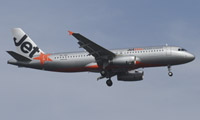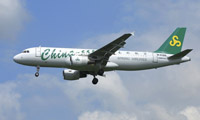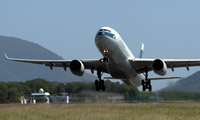Main Story
ASIA'S LCC BOOM: A CHINA TWIST
The proliferation of low-cost carriers in the Asia-Pacific has highlighted a major shift towards North Asia and, in particular, China. The question is: will Beijing continue to allow a growing number of overseas budget operators on to its international routes?
May 1st 2012
If the proposed no-frills carrier, Jetstar Hong Kong, secures the go-ahead from Hong Kong aviation regulators – and that is by no means guaranteed – it will represent a major first in the region’s airline industry. Never before has a Mainland Chinese operator, in this case Shanghai-based China Eastern Airlines, partnered with a Western network carrier, Qantas Airways, to launch a budget or, indeed, any new passenger airline. Read More »
 |
| Qantas Airways is hoping to add to its Jetstar brand with the proposed launch of Jetstar Hong Kong, a joint venture between Qantas and China Eastern Airlines |
But the 50-50 joint venture, which is aiming to launch in the middle of next year, has opened a can of worms. It has raised the question about the number of low-cost operators the Asia-Pacific can support and if Beijing will continue to allow an endless number of no-frills carriers to ply its international air routes. China itself has only one low-cost carrier (LCC), privately controlled Spring Airlines.
There are 46 budget airlines flying in the region (including the Indian subcontinent) and by mid-2013 six more will have joined their ranks. Most of them are targeting markets in North Asia, including Japan and Korea, but particularly China. Qantas chief executive, Alan Joyce, has forecast there will be a Mainland airline passenger market of 450 million by 2015.
According to Orient Aviation industry sources in Beijing, while Chinese aviation regulators continue to see liberalization and the growth of China’s own carriers as a key to strong economic development, some officials at the Civil Aviation Administration of China (CAAC) are becoming increasingly nervous about the soaring demand for access from rising numbers of budget airlines across the region.
It is hardly surprising. Asia-Pacific LCCs have more than 1,000 jets, mostly single-aisle, on order and they see China as the prime source of passengers to fill their seats in the coming years.
There is another major issue for fast-expanding budget operators: the region’s airports, even the massive new facilities built in the past decade, are becoming congested as they strive to meet capacity demands from network carriers increasing services into the world’s fastest growing air traffic market. This has been exacerbated by the explosion in the number of budget flights bringing rises in aircraft movements at a far faster rate than expected.
 |
| Spring Airlines: China’s only LCC, but it lacks access to Beijing and Shanghai |
That problem was underscored by a little reported aspect of the Jetstar Hong Kong deal. It won’t fly to China’s two major hubs, Beijing and Shanghai, where massive, almost brand new terminals are reaching capacity.
Instead, it will link Hong Kong with a wide range of secondary destinations in China. Chinese authorities are severely restricting LCC access to the two major hubs to protect their big full-service airlines.
China is going to be very busy weighing up air rights requests from LCCs. Singapore Airlines’ new long-haul budget operation, Scoot, launching in June, has China on its priority route list. New LCCs Jetstar Japan (flying from July), AirAsia Japan (to fly from August) and Thai Airways International’s new LCC, Thai Smile (launching in July), all want a piece of the China pie. Japan’s Peach Air, which began flying earlier this year and is part-owned by All Nippon Airways (ANA), is applying for rights to fly to Hong Kong, which is currently served by 11 LCCs, although none of these are home-based in the Chinese Special Administrative Region (SAR).
That will change in July or August when existing local operator, Hong Kong Express, part-owned by China’s HNA Group (Hainan Airlines) re-launches as an LCC.
Korean and Taiwanese budget airlines are also throwing heavy metal into China, with Jeju Air and Air Busan from Korea and Taiwan’s Eastar Jet and T’way Airlines launching new services to the Mainland in recent months and asking for more routes.
In the meantime, the March announcement by China Eastern and Qantas that they wanted to establish Jetstar Hong Kong sparked both controversy and mixed reactions from analysts.
The two airlines will invest up to $198 million in the joint venture over three years. Flying would start in mid-2013 with three A320 aircraft. The fleet will expand to 18 by 2015.
 |
| China Eastern Airlines chairman and president, Liu Shaoyong: forecast Jetstar Hong Kong would be profitable by the third year |
But industry observers pointed to potential regulatory hurdles. A former Cathay Pacific Airways executive and one-time chief executive of Viva Macau, Andrew Pyne, said the deal was “blatantly unconstitutional” in an article published in Hong Kong’s South China Morning Post.
In his opinion, neither Qantas nor China Eastern, which are “controlled in effect from Sydney and from Shanghai” can be said to have their principal place of business in Hong Kong. It means the project does not comply with Hong Kong’s Basic Law and that the law would have to be tweaked to legitimize the joint venture.
Analyst Mark Webb, head of conglomerate and transport research at HSBC Global Research, in Hong Kong, believes Pyne has a point. “It raises a lot of questions about ownership and control and how it works,” said Webb.
He even questioned why the new venture had to be set up in Hong Kong at all. “I’d rather set up a low-cost carrier in Shenzhen [on the Pearl River Delta close to Hong Kong] because you have lower costs there. It would be a classical secondary airport to Hong Kong. There are already people who cross the border and fly from Shenzhen to Chinese destinations because it’s cheaper,” he said.
Webb pointed out that Shenzhen’s airport could be reached by bus or ferry from central Hong Kong and was only a short distance further to travel than the city’s own airport.
He recognized, however, that Qantas could have other plans because of the way it integrates its subsidiary Jetstar’s operations with its mainline flying. It has passenger feed considerations and connecting traffic between Qantas and Jetstar will obviously be far more convenient at the Hong Kong International Airport.
In China, however, political pressure is everything and sources suggested Beijing supports the Jetstar Hong Kong concept. Qantas and China Eastern senior executives have discussed the new airline with Hong Kong aviation officials and are “confident” it will receive the go-ahead.
For its part, Qantas has acknowledged traffic rights in Hong Kong are based on the principle of business test and said the new company would be based in Hong Kong and led by a local board and management team.
| 'There is growing concern airports won’t be able to handle the levels of growth being driven by the LCCs' |
Regulatory hurdles may not be the only challenge for Jetstar Hong Kong. Analysts agreed the city had never been an ideal base for low-cost flights, for several reasons. Standard & Poor’s airline analyst, Shukor Yusof, said Hong Kong had strict bilateral agreements which limited frequencies and destinations, the domestic market was small and there was no budget airline terminal, as there were at hubs such as Singapore and Kuala Lumpur.
“There is also a cost in setting up which would be quite expensive. Landing and labour costs are high,” said Yusof.
Citigroup, in a report noting a third runway would not be built at the Hong Kong airport until 2020, suggested that with a current utilization rate of 89%, Hong Kong had less incentive to offer discounts to LCCs. Budget carriers have a 5% share of the Hong Kong market, compared with 27% in Singapore.
HSBC’s Webb believed Jetstar would have some difficulties taking its business to Hong Kong. By not flying to Shanghai or Beijing, which are the most profitable markets, “they are limiting themselves to a relatively small amount of the market where, at the moment, profitability is probably a lot less and the density of routes is quite thin,” he said.
Clearly, that decision has been taken to avoid any issues with Jetstar competing with China Eastern itself, he added.
Qantas boss Joyce refused to say how long he thought it would take for the new joint venture to become profitable. Bur China Eastern chairman and president, Liu Shaoyong, said he expected the new carrier to be in the black in its third year.
 |
| 'In North Asia, we are closing in on Japan. That is where our next launch will be [AirAsia Japan]. The next [area of] potential is South Korea' |
| Tony Fernandes Chief Executive AirAsia Group |
Responses from Hong Kong’s airlines, Cathay Pacific Airways, its wholly-owned subsidiary, Dragonair, which flies to 18 destinations on the Mainland and Hong Kong Airlines, have been muted. But to be sure, Cathay in particular will not take the situation lying down.
Analysts believe the carriers will call for a judicial review, a process that will potentially cause long delays and make the joint venture’s plans for a mid-2013 launch extremely optimistic.
Officially, Cathay said it is far too early to comment on specifics because the proposed venture remains subject to regulatory approval. “Cathay Pacific is pro-competition and we will continue to do our utmost, as Hong Kong’s home carrier, in building Hong Kong as a leading global aviation hub,” said the carrier in a statement.
“Our investment in new aircraft and products and new services between now and year 2019 amounts to $24.5 billion.”
Cathay declined to make any further comment when approached by Orient Aviation. Hong Kong Express chief executive, Kalid Razack, also did not respond to inquiries.
Jetstar chief executive, Bruce Buchanan, described the move as a “unique opportunity to capitalise on the enormous potential of the Greater China market, where the penetration of low-cost carriers is less than five percent”.
The Jetstar brand operates up to 3,000 flights in the Asia-Pacific every week to almost 60 destinations, including 30 in Asia and eight in Greater China. It expects to carry more than 20 million people this year.
At present only JetstarAsia in Singapore serves China, but Buchanan said the new Jetstar Japan plans to do so and Jetstar Pacific in Vietnam will follow “in the not too distant future”.
China Eastern’s Liu said the carrier had a 20-year relationship with Qantas and he believed there were huge opportunities for the Jetstar low-fares model throughout Asia, including Greater China.
 |
| Cathay Pacific Airways: says it is “pro-competition”, but is likely to fight the Jetstar Hong Kong move |
“Cooperation with Qantas is a key step in China Eastern Airlines’ international expansion strategy. Jetstar Hong Kong’s low-fare model will enable people to fly more often for less and will help to stimulate the Hong Kong tourism industry and the broader economy,” he said.
On a wider front, budget carriers targeting China will almost certainly have to take what they are given in the future and that will mostly be access to secondary airports.
Chinese regulators “want the three large PRC airlines to have businesses that are strong enough to allow them to compete effectively internationally. The perception is, almost certainly quite rightly, that if you liberalize domestically and allow LCCs into the domestic market then it is going to create substantial problems for the full-service airlines,” said one China-based analyst who did not want to be named.
He pointed to budget carrier Spring Airlines as an example. “It has done very well to a degree, but it has always lacked access to the Shanghai-Beijing route. If you don’t have frequencies on a route you are not a threat. That protects the full service airlines in China,” added the analyst.
Meanwhile, budget operators are also focusing on other North Asia destinations. Japan and Korea have become particular targets for LCC start-ups and new flights.
The region’s largest LCC, Malaysia’s AirAsia, is ramping up its presence and group chief executive, Tony Fernandes, confirmed it is looking at more options. “In North Asia, we are closing in on Japan. That is where our next launch will be [AirAsia Japan]. The next [area of] potential is South Korea,” he said.
But there is growing concern airports won’t be able to handle the levels of growth being driven by the LCCs. There is already congestion on the taxiways and at check-in desks, immigration control, security checkpoints and baggage carousels at major airports across the Asia-Pacific.
| 'There will be casualties. Not all of the LCCs will survive' |
| Shukor Yusof Airline Analyst Standard & Poor’s |
Trouble spots include Jakarta, Bangkok and Manila. Jakarta’s Soekarno-Hatta Airport is handling 51 million passengers a year, more than twice the design capacity when it was built in the mid-1980s. The wait at immigration at Bangkok’s Suvarnabhumi Airport can sometimes take two hours and the facility is running over capacity less than six years after opening.
And in China, the expected growth engine for the LCCs, there are no budget terminals - and none planned.
Some airports are taking measures to ease current congestion and prepare for the growth ahead. Malaysia Airports will complete a new $1.7 billion budget terminal at Kuala Lumpur in April next year. Initially planned to handle 30 million passengers annually, that figure has been increased to 45 million.
Singapore Changi International Airport, where passenger numbers are rising at 12% annually, plans to build a fourth terminal. This will boost total capacity to 82 million passengers a year from the current 73 million when it is completed in 2017.
At Jakarta, a third runway and fourth terminal are in the pipeline, but work hasn’t started yet and land acquisition issues are causing planning problems.
Tokyo’s Narita airport has recently announced it will build a low-cost terminal by 2015. It will be sorely needed with new LCCs like Peach already flying and entrants such as Jetstar Japan and AirAsia Japan coming on line this year.
In a recent report, consultants CAPA said Changi’s fourth terminal might not be enough to meet the expected surge in air travel. “A third runway and a fifth terminal will eventually be needed for Singapore to maintain its status as a leading hub,” it said.
There was a warning, too, from Andrew Herdman, director general of the Association of Asia Pacific Airlines (AAPA): “You can buy as many aircraft as you like, but if the infrastructure does not keep up then you are going to see a degraded service that may prevent you from executing plans to grow the airline,” he said.
Looking to the future, analysts believe the growth in LCCs cannot continue indefinitely. Standard & Poor’s Yusof believes it will be a case of the survival of the fittest. “There will be casualties. Not all of the LCCs will survive,” he said.
He believes there will be consolidation with the budget market dominated by the major LCC operators such as AirAsia, Jetstar, Tiger Airways, Indonesia’s Lion Air and the Philippines’ Cebu Pacific Air.